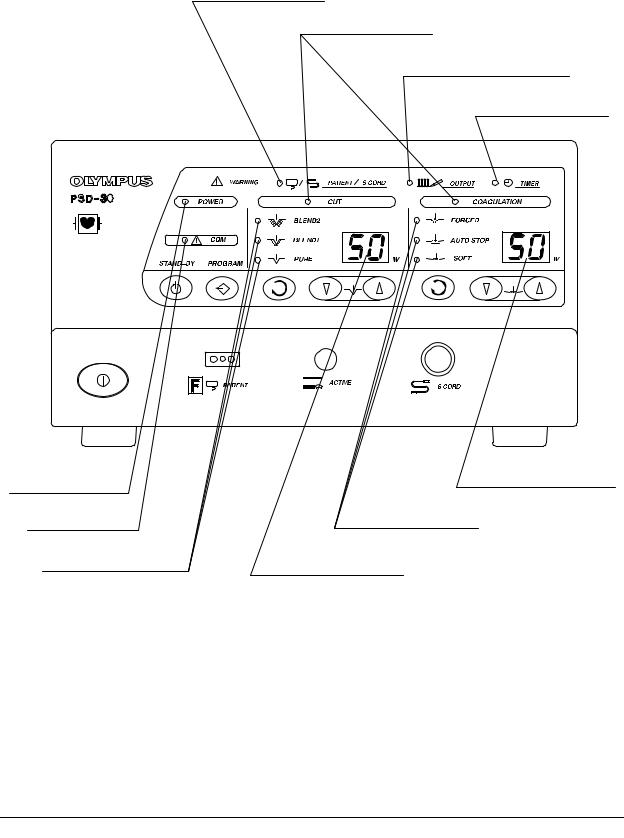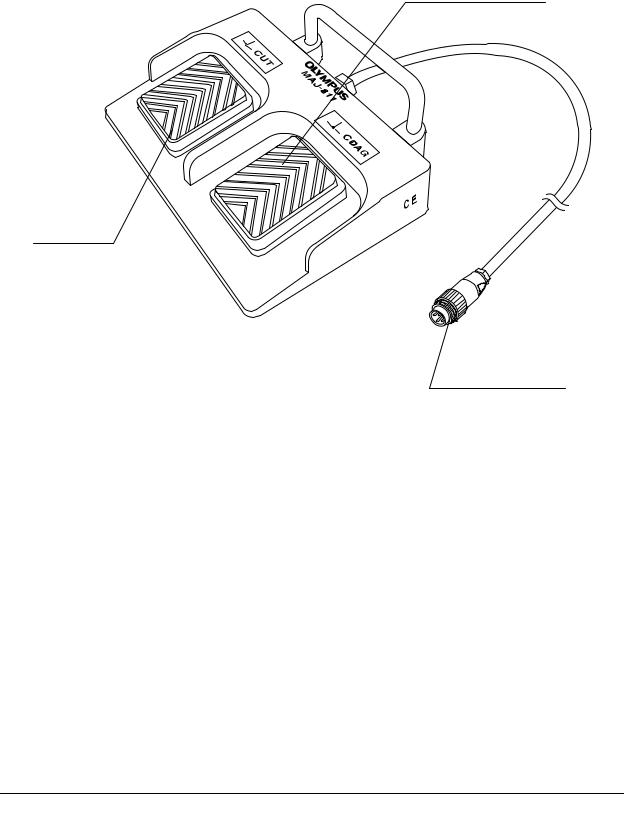Olympus PSD-30 User manual

INSTRUCTIONS
ELECTROSURGICAL UNIT
PSD-30

|
|
Contents |
Contents |
|
|
Labels and Symbols..................................................................... |
1 |
|
Important Information — Please Read Before Use.................... |
3 |
|
Intended use ............................................................................................ |
3 |
|
Applicability of endoscopic treatment ....................................................... |
3 |
|
Instruction manual..................................................................................... |
4 |
|
User qualifications .................................................................................... |
4 |
|
Instrument compatibility ........................................................................... |
4 |
|
Repair and modification ............................................................................ |
5 |
|
Signal words ............................................................................................. |
5 |
|
Dangers, warnings and cautions .............................................................. |
5 |
|
Chapter 1 Checking the Package Contents............................ |
12 |
|
Chapter 2 Nomenclature and Functions................................. |
14 |
|
2.1 |
Symbols and descriptions ............................................................... |
14 |
2.2 |
Front panel...................................................................................... |
17 |
2.3 |
Rear panel ...................................................................................... |
21 |
2.4 |
Foot switch (MAJ-811) .................................................................... |
22 |
2.5 |
S-cord (MAJ-813)............................................................................ |
23 |
2.6 |
P cord (MAJ-814)............................................................................ |
23 |
Chapter 3 Installation and Connection ................................... |
24 |
|
3.1 |
Installation of equipment ................................................................. |
24 |
3.2 |
Connection to an AC mains power supply ...................................... |
25 |
3.3 |
Connection of the foot switch.......................................................... |
26 |
3.4 |
Connection of the patient plate ....................................................... |
27 |
3.5Connection of the S-cord (when using an endoscope with a S-cord
|
connector mount) ............................................................................ |
32 |
3.6 |
Connection of the A-cord ................................................................ |
33 |
Chapter 4 |
Inspection ................................................................ |
35 |
4.1 |
Inspection of the power supply ....................................................... |
35 |
4.2 |
Inspection of the foot switch............................................................ |
38 |
4.3 |
Inspection of the warning functions................................................. |
39 |
4.4 |
Inspection of the cut mode and output............................................ |
40 |
4.5 |
Inspection of the coagulation mode and output .............................. |
41 |
ELECTROSURGICAL UNIT PSD-30 |
i |

Contents
Chapter 5 |
Operation.................................................................. |
43 |
5.1 |
Turn the power ON ......................................................................... |
44 |
5.2 |
Selection of cut mode ..................................................................... |
45 |
5.3 |
Selection of coagulation mode........................................................ |
46 |
5.4 |
Setting output.................................................................................. |
47 |
5.5 |
Program mode ................................................................................ |
48 |
5.6 |
Electrosurgery................................................................................. |
51 |
5.7 |
Stand-by mode................................................................................ |
53 |
5.8 |
Adjusting the volume....................................................................... |
55 |
5.9 |
Procedure after use ........................................................................ |
56 |
Chapter 6 Care, Storage and Disposal .................................... |
58 |
|
6.1 |
Care ................................................................................................ |
58 |
6.2 |
Storage ........................................................................................... |
59 |
6.3 |
Disposal .......................................................................................... |
59 |
Chapter 7 |
Troubleshooting ...................................................... |
60 |
7.1 |
Troubleshooting guide .................................................................... |
60 |
7.2 |
Alarm functions ............................................................................... |
69 |
7.3 |
Returning the electrosurgical unit for repair .................................... |
73 |
Appendix........................................................................................ |
|
74 |
Construction ............................................................................................. |
74 |
|
System chart ............................................................................................. |
75 |
|
Operating environment ............................................................................. |
77 |
|
Specifications ............................................................................................ |
78 |
|
EMC information........................................................................................ |
86 |
|
ii |
ELECTROSURGICAL UNIT PSD-30 |

Labels and Symbols
Labels and Symbols
Safety-related labels and symbols are attached to the instrument at the location shown below.
If labels or symbols are missing or illegible, contact Olympus.
Rear side
Fuse rating
CE marking
Potential equalization terminal
Foot switch connector
Electrical rating
Product name, rated voltage and current are displayed.
Serial number
Crossed-out wheeled bin’ symbol
ELECTROSURGICAL UNIT PSD-30 |
1 |

Labels and Symbols
Electrical rating
ELECTROSURGICAL UNIT
MODEL |
PSD-30 |
INPUT |
220V – 240V |
|
2A |
|
50/60Hz |
MONOPOLAR : 50W/300Ω (SOFT/AUTO STOP 100Ω)
350kHz INT.10S/30S
Back cover of this instruction manual
Manufacturer
Authorised representative in the European Community
2 |
ELECTROSURGICAL UNIT PSD-30 |

Important Information — Please Read Before Use
Important Information — Please Read
Before Use
•High frequency leakage current or spark discharge may cause patient, operator and assistant burns. Follow the dangers, warnings and cautions described in this instruction manual when using this electrosurgical unit.
•Always prepare for an emergency operation in case of unintentional patient burn, bleeding and perforation.
Intended use
This electrosurgical unit has been designed to be used with an Olympus endoscope (fiberscope or videoscope) compatible with electrosurgery, light source, electrosurgical accessories and other ancillary equipment for general and endoscopic electrosurgery (cutting and coagulation).
Do not use this electrosurgical unit for any purpose other than its intended use.
Applicability of endoscopic treatment
If there is an official standard on the applicability of endoscopic treatment as defined by a national or local medical administration, or other institution, such as an academic society, follow that standard when performing the procedure. Before performing endoscopic treatment, thoroughly study the properties, purposes, effects and possible risks (the nature, extent, probability and imminence) of the planned treatment and any alternative therapeutic method that can be performed. Carry out endoscopic treatment only when its benefits outweigh its risks. Fully explain to the patient the possible benefits and risks of endoscopic treatment as well as those of any therapeutic method(s) that can be performed instead of endoscopy, and perform endoscopic treatment only after patient consent is granted. During endoscopic treatment, continue to evaluate the potential benefits and risks, and stop the treatment if the risks become greater than the possible benefit to the patient.
ELECTROSURGICAL UNIT PSD-30 |
3 |

Important Information — Please Read Before Use
Instruction manual
This instruction manual contains essential information on using this electrosurgical unit safely and effectively.
Before use, thoroughly review this manual and the manuals of all equipment which will be used during the procedure and use the equipment as instructed. Keep this and all related instruction manuals in a safe, accessible location.
If you have any questions or comments about any information in this manual, please contact Olympus.
Terms used in this manual
Wall mains outlet
An electrical outlet that has a terminal used exclusively for grounding.
User qualifications
If there is an official standard that outlines the qualifications required of medical personnel performing endoscopic treatments as defined by a national or local medical administration or other institution, such as an academic society, follow that standard. If there is no such standard, the operator of this instrument must be a physician who has been approved by the hospital’s medical safety manager or surgical department manager.
Instrument compatibility
Refer to the “System chart” in the Appendix to confirm that this electrosurgical unit is compatible with the ancillary equipment being used.
Using incompatible equipment can result in patient injury and/or equipment damage.
4 |
ELECTROSURGICAL UNIT PSD-30 |

Important Information — Please Read Before Use
Repair and modification
This electrosurgical unit does not contain any user-serviceable parts. Do not disassemble, modify or attempt to repair it; patient or user injury and/or equipment damage can result. This instrument is to be repaired by Olympus technicians only.
Some problems that appear to be malfunctions may be correctable by referring to Chapter 7, “Troubleshooting”.
If the problem cannot be resolved using the information in Chapter 7, contact Olympus.
Signal words
The following signal words are used throughout this manual:
Indicates an imminently hazardous situation which, if not avoided, will result in death or serious injury.
Indicates a potentially hazardous situation which, if not avoided, could result in death or serious injury.
Indicates a potentially hazardous situation which, if not avoided, may result in minor or moderate injury. It may also be used to alert against unsafe practices or potential equipment damage.
Indicates additional helpful information.
Dangers, warnings and cautions
Follow the dangers, warnings and cautions described below when handling this electrosurgical unit. This information is to be supplemented by the dangers, warnings and cautions given in each chapter.
ELECTROSURGICAL UNIT PSD-30 |
5 |

Important Information — Please Read Before Use
•The HF equipment, when applied to a patient with a pacemaker implanted, may cause malfunctioning or failure of the pacemaker and may seriously affect the patient. Always confirm that it is safe to proceed with a cardiologist and the manufacturer of the pacemaker before proceeding.
•To prevent shock hazards, never apply the PSD-30 to the heart in combination with TYPE B or TYPE BF applied parts.
•When using the electrosurgical unit on or in the vicinity of the heart, be sure to use it with the minimum necessary output. Spark discharge during operation may affect the heart.
•Never install or operate the electrosurgical unit in locations where:
−the concentration of oxygen is high.
−oxidizing agents (such as nitrous oxide (N2O)) are present in the atmosphere.
−flammable anesthetics are present in the atmosphere.
−flammable gases are present in the atmosphere.
Otherwise, explosion or fire may result and cause damage to human body. Because this electrosurgical unit is not explosion-proof.
•The PSD-30 has been designed for flexible endoscopic applications. Therefore, do not use it for surgical operations.
•Always use the S-cord when endoscopic treatment is performed with an endoscope equipped with the S-cord connector mount. When using an endoscope without the S-cord connector mount, refer to the instruction manual and confirm that the electrosurgery is feasible with this endoscope. If the electrosurgical unit is used in conjunction with an endoscope that is not feasible with the electrosurgery, a burn to the patient, the operator or the assistant may occur.
•If the electrosurgical unit fails and the output is stopped during treatment, it may be impossible to continue treatment due to adhesion of the endo-therapy accessory to a mucous tissue or other accident. Prepare a spare electrosurgical unit as backup to ensure that the procedure can be completed without complication in case of a malfunction.
6 |
ELECTROSURGICAL UNIT PSD-30 |

Important Information — Please Read Before Use
•Always have a defibrillator ready in case of a cardiac emergency. During operation of the defibrillator, remove the endoscope from the patient.
•To respond to possible patient bleeding, prepare at least the following three hemostatic procedures: coagulation, clipping and local injection.
•To prepare for possible accidents, emergency equipment for life-saving, intubation and appropriate pharmaceuticals should be located in or near the procedure room.
•Never attach the patient plate in the vicinity of a metal implant. The tissue in the vicinity of the metal implant may be burned.
•Keep the electrosurgical unit and ancillary cords (A-cord, P cord, S-cord) as far away as possible from other
electromedical equipment and cords. If placed too close, high frequency signals or spark discharge noise from the electrosurgical unit may interfere with the operation of other equipment.
•To prevent patient burns, the electrosurgical unit and ancillary cords (A-cord, P cord, S-cord) should not come in contact with the patient or metal parts of the operating table. Furthermore, patients should also keep away from metallic parts of the operating table or other devices.
•Never loop the cords (A-cord, P cord, S-cord) or bundle cords together with cords belonging to other medical equipment. The high frequency signals or spark discharge noise generated by the electrosurgical unit may interfere with the operation of other medical equipment.
•The electrosurgical unit may interfere with electromedical equipment used in conjunction with it. Before use, thoroughly confirm the compatibility of all the equipment.
•Do not bring the tip of the electrosurgical accessory close to a metal clip or other accessories. The tissue around the metal clip or the accessory may be burned.
•To prevent electric shock, the electrosurgical unit is designed to function with insulated connectors that have Type CF electromedical equipment classifications (A-cord, P cord,
P plate, S-cord). Therefore, to prevent shock caused by leakage current from other electrical equipment applied to the patient, the connectors from the other equipment should not be grounded.
ELECTROSURGICAL UNIT PSD-30 |
7 |

Important Information — Please Read Before Use
•Should any abnormal output be suspected during operation, immediately terminate the use of the equipment and turn OFF the electrosurgical unit.
•To prevent operator shock, electrosurgical unit malfunction and electrosurgical unit damage, keep liquids away from all electrical equipment. If liquid gets on or into the electrosurgical unit, terminate operation immediately and contact Olympus.
•To prevent patient burns, the patient’s skin surfaces should not touch each other (e.g. bare arm and side of chest) or any metal items in the procedure room. Remove any metallic items from the patient (wristwatches, jewelry, etc.) before starting the procedure.
•To prevent patient burns, the patient’s clothes must be dry.
•To prevent operator and assistant burns, be sure to wear chemical-resistant gloves during operation.
•If the intestines contain a flammable gas, replace this gas with air or a non-flammable gas before performing the operation, to minimize the risk of fire or explosion.
•The endoscopic treatment performed should not include a therapy with which part of the treated tissue (poly head, etc.) or part of the endoscope distal end or endo-therapy accessory is in contact with or close to normal tissue. Otherwise, current flows to the normal tissue through the part of the treated tissue, the metallic parts at the endoscope’s distal end or endo-therapy accessory and may cause burns.
•Be sure that the distal end of endoscope or accessory does not contact bridging fluids surrounding the target tissue. Electric current may flow to the surrounding normal tissue via the fluids and cause burns.
•Never grasp the target tissue with non-insulated grasping forceps. Non-insulated grasping forceps will disperse the electric current and normal operation may be impeded.
•To ensure electrical safety, the electrosurgical unit should not be used in conjunction with:
−Electrical equipment whose safety against leakage current is not guaranteed.
−Electrosurgical equipment whose safety in combined use is not guaranteed.
8 |
ELECTROSURGICAL UNIT PSD-30 |

Important Information — Please Read Before Use
•If the electrosurgical unit is used in conjunction with a non-Olympus electrosurgical unit, keep the electrosurgical accessory away from the target area while the electrosurgical unit is in operation. Do not activate output of both units simultaneously. Patient or operator injury may occur due to the concentration of electric current.
•When using an electrocardiograph or other physiological monitoring equipment simultaneously with the electrosurgical unit on a patient, any monitoring electrodes should be placed as faraway as possible from the electrodes and patient plate used with the electrosurgical unit. If placed too close, high frequency signals or spark discharge noise from the electrosurgical unit may interfere with the operation of an electrocardiograph or other physiological monitoring equipment. Needle monitoring electrodes should not be used, as they may cause patient burns. Physiological monitoring equipment incorporating high frequency current limiting devices is recommended.
•Use physiological monitoring equipment throughout the entire procedure, for continuous observation of the patient’s condition.
•The open-circuit voltage output characteristics of the electrosurgical unit are shown below. When setting the output level, first set it to a low output level and increase it gradually. If the output is initially set to an excessive level, the electrode’s insulation could be damaged, which could cause operator and/or patient burns. Furthermore, it is recommended that you perform basic experiments before using the electrosurgical unit. If the instruction manual for the endoscopic accessory to be used stipulates a rated voltage, the output should be set so that it does not exceed that voltage.
ELECTROSURGICAL UNIT PSD-30 |
9 |

Important Information — Please Read Before Use
1000 |
|
(1) |
|
|
|
|
|
|
|
|
|
800 |
|
(3) |
|
|
(1) PURE |
|
|
|
(2) |
(2) BLEND1 |
|
|
|
|
|
||
600 |
|
|
|
(3) BLEND2 |
|
|
|
|
|
||
|
(6) |
|
|
(4) SOFT |
|
|
|
|
|
|
(5) AUTO STOP |
400 |
|
|
|
|
(6) FORCED |
200 |
|
(4) |
(5) |
|
|
|
|
|
|
|
|
0 |
0 |
20 |
40 |
|
60 |
|
|
OUTPUT (W) |
|
|
|
•Flammable agents used for cleaning and disinfection must be allowed to evaporate before the electrosurgical unit is used. Also ensure that flammable solutions are neither on the patient’s skin nor in the patient’s body cavity when the electrosurgical unit is used.
•To prevent patient burns when the electrosurgical unit is used in conjunction with a non-Olympus electrosurgical unit, ensure that each unit is supplied with power from wall mains outlets. Also ensure that each unit is supplied with power from separate breakers.
•During operation, temporarily unused electrodes should be stored in an electrically insulated container. Unused electrodes should never be placed on the patient otherwise it may cause operator and/or patient burns.
•The electrosurgical unit should not be used for performing circumcisions.
•To prevent patient burns, never use cords with scratches or cracks.
•Studies have shown that smoke generated during electrosurgical procedures can be irritating and potentially harmful to surgical personnel. These studies recommend the use of surgical masks and adequate ventilation of smoke by the use of surgical smoke evacuators or other means.
10 |
ELECTROSURGICAL UNIT PSD-30 |

Important Information — Please Read Before Use
−William S.Sawchuk, et al., “Infections Papilomavirus in the Vapor of Warts Treated With Laser or Electrocoagulation: Detection and Protection”, Journal of American Academy of Dermatology, Vol.21, No.1 (July, 1989): 41-49.
Yoshifumi Tomita, et al., “Mutagencity of Smoke
Condensates Induced by CO2-Laser Irradiation and Electrocauterization”, Mutation Research, Vol.89 (1989): 145-149.
Evaluation Report No.85-126. (National Technical Information Service, 1985): 1-28.
•When the patient is moved after the dispersive electrode has been attached, confirm that the dispersive electrode is still in proper contact with the patient otherwise it may cause operator and/or patient burns.
•Do not use the electrosurgical unit in a location exposed to strong electromagnetic radiation (microwave medical treatment equipment, short wave medical treatment equipment, MRI, radio or mobile phone). Electrosurgical unit malfunction can occur.
•To prevent electrosurgical unit damage, never short-circuit electrodes (accessories, patient plate).
•Repairs should be performed only by Olympus.
•The electrosurgical unit should only be used in accordance with the conditions described in “Operating environment” in the Appendix. The use under other conditions may impede normal performance, and/or result in equipment damage.
•During treatment, be sure that the distal (metallic) end of the endoscope, and metallic parts of accessory do not touch the normal tissue surrounding the target tissue. This action may cause severe burns.
ELECTROSURGICAL UNIT PSD-30 |
11 |

Chapter 1 Checking the Package Contents
Chapter 1 Checking the Package
Contents
Match all items in the package with the components shown below. Inspect each item for damage. If the electrosurgical unit is damaged, a component is missing or you have any questions, do not use the electrosurgical unit; immediately contact Olympus.
Power cord
Electrosurgical unit (PSD-30)
P cord (MAJ-814)
S-cord (MAJ-813)
Foot switch (MAJ-811)
Spare fuse |
P plate |
(MAJ-1052, 2 pcs) |
(MAJ-897, 10 pcs) |
Instruction manual
12 |
ELECTROSURGICAL UNIT PSD-30 |

Chapter 1 Checking the Package Contents
The following Olympus items are optional and may be purchased separately:
•A-cord (MA-255, MH-969)
•P plate (MB-574)
•P cord (MAJ-3)
•P adapter (MAJ-812)
For other combinations, refer to the “System chart” in the Appendix.
•Place the instruction manual next to the electrosurgical unit or in another easily accessible place.
•Before using an optional item, thoroughly review and understand the instruction manual provided with that item.
ELECTROSURGICAL UNIT PSD-30 |
13 |

Chapter 2 Nomenclature and Functions
Chapter 2 Nomenclature and Functions
2.1Symbols and descriptions
Warning section
Refer to instructions
Patient plate
S-cord
High frequency output
Output timer
Coag. section
 Soft
Soft
Auto stop
Forced
14 |
ELECTROSURGICAL UNIT PSD-30 |

Chapter 2 Nomenclature and Functions
Cut section
 Pure
Pure
Blend1
Blend2
Power switch
Power ON/OFF
Front panel
Type CF applied parts (defibrillation protected equipment)
STAND-BY
Program
ELECTROSURGICAL UNIT PSD-30 |
15 |

Chapter 2 Nomenclature and Functions
Connector section
 Active
Active
S-cord
Patient plate
Refer to instructions
Connection for neutral electrode (isolated from earth at high frequency)
Rear panel
Potential equalization terminal
Foot switch
Fuse
Alternating current
Serial number
16 |
ELECTROSURGICAL UNIT PSD-30 |

Chapter 2 Nomenclature and Functions
2.2Front panel
|
|
2. Program switch |
3. Cut mode selector |
||||||||||||||||||
|
|
|
|
|
|
|
|
|
|
|
|
|
|
||||||||
1. Stand-by switch |
|
|
|
|
|
4. Output control buttons |
|||||||||||||||
|
|
|
|
|
|
|
|
|
|
|
|
||||||||||
|
|
|
|
|
|
|
|
|
|
|
|
|
|
|
|
|
|
|
|
|
|
|
|
|
|
|
|
|
|
|
|
|
|
|
|
|
|
|
|
|
|
|
|
|
|
|
|
|
|
|
|
|
|
|
|
|
|
|
|
|
|
|
|
|
|
|
|
|
|
|
|
|
|
|
|
|
|
|
|
|
|
|
|
|
|
|
|
|
|
|
|
|
|
|
|
|
|
|
|
|
|
|
|
|
|
|
|
|
|
|
|
|
|
|
|
|
|
|
|
|
|
|
|
|
|
|
|
|
|
|
|
|
|
|
|
|
|
|
|
|
|
|
|
|
|
|
|
|
|
|
|
|
|
|
|
|
|
|
|
|
|
|
|
|
|
|
|
|
|
|
|
|
|
|
|
|
|
|
|
|
|
|
|
|
|
|
|
|
|
|
|
|
|
|
|
|
|
|
|
|
|
|
|
|
|
|
|
|
|
|
|
|
|
|
|
|
|
|
|
|
|
|
|
|
|
|
|
|
|
|
|
|
|
|
|
|
|
|
|
|
|
7. Active connector
5. Coagulation mode
9. Power switch |
selector |
|
8. Patient plate |
||
|
||
|
connector |
|
|
6. S-cord connector |
ELECTROSURGICAL UNIT PSD-30 |
17 |

Chapter 2 Nomenclature and Functions
10.Patient/S-cord warning indicator
11.Output indicators
12.High frequency output warning indicator
13.Output time warning indicator
14. Coagulation output
19. Power indicator |
setting indicator |
|
|
|
15. Coagulation mode |
18. CQM indicator |
indicators |
17. Cut mode indicators |
16. Cut output setting |
indicator |
18 |
ELECTROSURGICAL UNIT PSD-30 |

Chapter 2 Nomenclature and Functions
1.Stand-by switch
This switch disables high frequency output and change of setting. In the stand-by mode, the output tone volume can be adjusted.
2.Program switch
This switch is pressed to store output setting and output mode and to recall stored output setting and output mode.
3.Cut mode selector
This selector is pressed to select the cut mode.
4.Output control buttons
When the “ ” button is pressed, the value of the output setting indicator increases. When the “
” button is pressed, the value of the output setting indicator increases. When the “ ” button is pressed, the value of the output setting indicator decreases.
” button is pressed, the value of the output setting indicator decreases.
5.Coagulation mode selector
This selector is pressed to select the coagulation mode.
6.S-cord connector
This connector connects the electrosurgical unit to the endoscope via the S-cord.
7.Active connector
This connector connects the electrosurgical unit to the active electrode via the A-cord.
8.Patient plate connector
This connector connects the electrosurgical unit to the patient plate via the P cord.
9.Power switch
This switch is pressed to turn ON/OFF the electrosurgical unit.
10.Patient/S-cord warning indicator
This indicator lights to indicate a defective connection of cords or broken wires in the P cord, patient plate or S-cord.
11.Output indicators
During output, the indicator corresponding to the selected output (cut, coagulation) is lit.
12.High frequency output warning indicator
This indicator lights to indicate that the output level is not in accordance with the set output level.
13.Output time warning indicator
This indicator lights if output continues for longer than the specified time.
14.Coagulation output setting indicator
This indicator displays the value set with the output control buttons.
15.Coagulation mode indicators
These indicators light when the corresponding coagulation mode selector is pressed.
ELECTROSURGICAL UNIT PSD-30 |
19 |

Chapter 2 Nomenclature and Functions
16.Cut output setting indicator
This indicator displays the value set with the output control buttons.
17.Cut mode indicators
These indicators light when the corresponding cut mode selector is pressed.
18.CQM indicator
When a split-type patient plate is connected, the CQM indicator lights to indicate that the connection between the patient and the patient plate is correct.
19.Power indicator
This indicator lights when the electrosurgical unit is turned ON.
20 |
ELECTROSURGICAL UNIT PSD-30 |

Chapter 2 Nomenclature and Functions
2.3Rear panel
4.Potential equalization terminal
1. Fuse box
3. Foot switch connector
2. AC power inlet
1.Fuse box
This box prevents short-circuits within the unit if equipment malfunctions.
2.AC power inlet
This inlet accepts the power cord.
3.Foot switch connector
This connector connects the foot switch (MAJ-811) to the electrosurgical unit.
4.Potential equalization terminal
To be equipotential, connect this terminal to a potential equalization busbar of the electrical installation.
ELECTROSURGICAL UNIT PSD-30 |
21 |

Chapter 2 Nomenclature and Functions
2.4Foot switch (MAJ-811)
2. Coagulation pedal
1. Cut pedal
3. Foot switch plug
1.Cut pedal
This pedal starts and stops the cut output.
2.Coagulation pedal
This pedal starts and stops the coagulation output.
3.Foot switch plug
This plug connects the foot switch to the electrosurgical unit.
22 |
ELECTROSURGICAL UNIT PSD-30 |

Chapter 2 Nomenclature and Functions
2.5S-cord (MAJ-813)
1.Plug on the unit side
2. Plug on the endoscope side
1.Plug on the unit side
This plug connects to the electrosurgical unit to the endoscope via S-cord.
2.Plug on the endoscope side
This plug connects the endoscope to the electrosurgical unit via the S-cord.
2.6P cord (MAJ-814)
3. Lever-locking |
1. Plug on the |
arm |
unit side |
2.Clamp
1.Plug on the unit side
This plug connects the patient plate to the electrosurgical unit via the P cord.
2.Clamp
This clamp connects the patient plate to the electrosurgical unit via the P cord.
3.Lever-locking arm
This arm locks the clamp securely in the connector of the patient plate.
ELECTROSURGICAL UNIT PSD-30 |
23 |

Chapter 3 Installation and Connection
Chapter 3 Installation and Connection
Prepare the electrosurgical unit and compatible equipment (shown in the “System chart” in the Appendix) before each use, and refer to the instruction manuals of each system component. Install and connect the equipment as follows:
3.1Installation of equipment
•Install the unit on a stable, level surface. Otherwise, the unit could fall, causing equipment damage and/or injury to the operator or patient.
•If the electrosurgical unit is placed on a cart, the cart must be of adequate strength and size to hold the unit securely.
•Never place the electrosurgical unit on its side or upside down. Otherwise, the electrosurgical unit does not work correctly.
Place the instruction manual near the electrosurgical unit or in another easily accessible place.
1.Ensure that the operation of the electrosurgical unit is in accordance with the precautions described in “Dangers, warnings and cautions” on page 5.
2.Place the electrosurgical unit on a level, stable bench or cart.
24 |
ELECTROSURGICAL UNIT PSD-30 |

Chapter 3 Installation and Connection
3.2Connection to an AC mains power supply
Connect the power plug of the power cord directly to a grounded wall mains outlet. If the electrosurgical unit is not grounded properly, it can cause an electric shock and/or fire.
•Do not bend, pull or twist the power cord. Electric shock, equipment damage and/or fire can result.
•To prevent the risk of electric shock, the housing of the electrosurgical unit must be grounded. Always connect the power cord plug to a properly grounded hospital grade AC receptacle (wall mains outlet).
•Always plug the power cord into a 3-pin outlet. Do not use a 3-pin/2-pin adapter, as it can impair the safe operation of the unit.
•Do not allow the power cord to become wet. Electric shock, equipment damage or fire can result.
•Always use the power cord provided with the electrosurgical unit. Never attempt to modify the power cord.
•If the same circuit breaker is used to supply power to other electrosurgical equipment, carefully consider the power requirements of the additional equipment and use circuit breakers that have ample capacity. Otherwise, the electrosurgical unit does not work correctly.
1.Confirm that the electrosurgical unit is turned OFF.
2.Connect the power cord to the AC power inlet of the electrosurgical unit and a wall mains outlet.
ELECTROSURGICAL UNIT PSD-30 |
25 |
